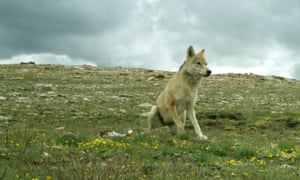Animal’s unique adaptation to low-oxygen life can be basis for protection, say researchers
Patrick BarkhamFri 21 Feb 2020

Researchers want the wolf to be given conservation status. Photograph: Geraldine Werhahn/Himalayan Wolves Project
Wolves living in the Himalayas are to be recognised as a subspecies of the grey wolf, with researchers predicting that the animals will soon be declared a unique species.
The wolves surviving at high altitudes in Nepal and on the Tibetan plateau possess a genetic adaptation to cope with the lack of oxygen that is not found in any other wolf, a study reports.
The research, published in the Journal of Biogeography, reveals the evolutionary uniqueness of the wolf based on a number of different genetic markers. It will now be used as the basis to recognise the Himalayan wolf formally as a subspecies, with its own scientific name.
This taxonomic recognition will pave the way for the wolf to be given a conservation status by the International Union for Conservation of Nature (IUCN), to help protect the population.
Lead researcher Dr Geraldine Werhahn, of the University of Oxford, said scientists still needed to obtain one final piece of genome data before the wolf could be classified as its own unique species.
“Everything is pointing towards it being eligible for full species status but we need to obtain high quality genetic samples, that’s the difficult part,” she said.
FacebookTwitterPinterest A Himalayan wolf pup. The animal survives on half the oxygen available to mammals at sea level. Photograph: Geraldine Werhahn/Himalayan wolves Project
Werhahn became the first known person to film a Himalayan wolf’s den during four research trips to the Himalayas.
The elusive wolf survives on half the oxygen available to mammals at sea level. “It is exhausting being up there, and that is a very strong evolutionary pressure,” said Werhahn, of WildCRU in Oxford’s Department of Zoology.
While the Himalayan wolf has hybridised with the grey wolf at lower altitudes, it has endured as a unique species at high altitudes because living there requires such strength. Grey wolves are unable to move in and take over such inhospitable territory.
The Himalayan wolf lives in packs of five animals on average – a smaller group than grey wolves – and eats marmots in summer as well as woolly hares and bharal, or Himalayan blue sheep. It prefers wild species but will also take livestock.
Werhahn said there was less conflict between Himalayan herders and the wolf than between livestock farmers and grey wolves in Europe, but Himalayan wolves are sometimes killed because of the threat they pose to yaks and other livestock. According to the researchers, local people want to help conserve the wolf and community conservation efforts have proved successful in the Himalayas.
Wolves living in the Himalayas are to be recognised as a subspecies of the grey wolf, with researchers predicting that the animals will soon be declared a unique species.
The wolves surviving at high altitudes in Nepal and on the Tibetan plateau possess a genetic adaptation to cope with the lack of oxygen that is not found in any other wolf, a study reports.
The research, published in the Journal of Biogeography, reveals the evolutionary uniqueness of the wolf based on a number of different genetic markers. It will now be used as the basis to recognise the Himalayan wolf formally as a subspecies, with its own scientific name.
This taxonomic recognition will pave the way for the wolf to be given a conservation status by the International Union for Conservation of Nature (IUCN), to help protect the population.
Lead researcher Dr Geraldine Werhahn, of the University of Oxford, said scientists still needed to obtain one final piece of genome data before the wolf could be classified as its own unique species.
“Everything is pointing towards it being eligible for full species status but we need to obtain high quality genetic samples, that’s the difficult part,” she said.

FacebookTwitterPinterest A Himalayan wolf pup. The animal survives on half the oxygen available to mammals at sea level. Photograph: Geraldine Werhahn/Himalayan wolves Project
Werhahn became the first known person to film a Himalayan wolf’s den during four research trips to the Himalayas.
The elusive wolf survives on half the oxygen available to mammals at sea level. “It is exhausting being up there, and that is a very strong evolutionary pressure,” said Werhahn, of WildCRU in Oxford’s Department of Zoology.
While the Himalayan wolf has hybridised with the grey wolf at lower altitudes, it has endured as a unique species at high altitudes because living there requires such strength. Grey wolves are unable to move in and take over such inhospitable territory.
The Himalayan wolf lives in packs of five animals on average – a smaller group than grey wolves – and eats marmots in summer as well as woolly hares and bharal, or Himalayan blue sheep. It prefers wild species but will also take livestock.
Werhahn said there was less conflict between Himalayan herders and the wolf than between livestock farmers and grey wolves in Europe, but Himalayan wolves are sometimes killed because of the threat they pose to yaks and other livestock. According to the researchers, local people want to help conserve the wolf and community conservation efforts have proved successful in the Himalayas.

Conservation scientists do not know the wolf’s population because it roams across a large swath of inaccessible terrain. Photograph: Geraldine Werhahn/Himalayan Wolves Project
Researchers still need to estimate the remaining number of Himalayan wolves. Conservation scientists currently have no idea of the wolf’s population because the animal roams across such a large swath of inaccessible terrain.
An IUCN classification “is really the basis that we need to get protection for the wolf”, Werhahn said. “Something without any sort of name is hard to get conservation in place for.”
No comments:
Post a Comment